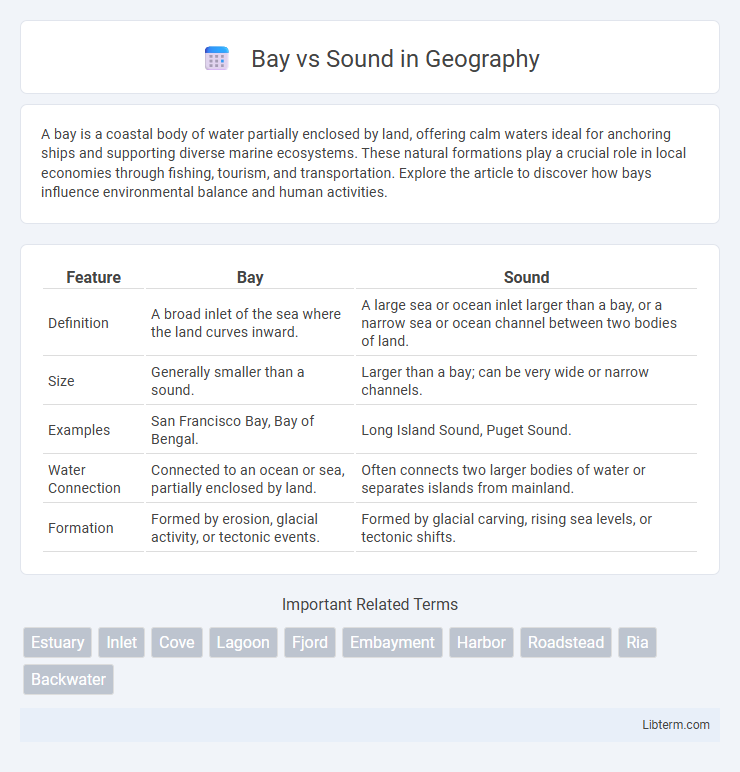A bay is a coastal body of water partially enclosed by land, offering calm waters ideal for anchoring ships and supporting diverse marine ecosystems. These natural formations play a crucial role in local economies through fishing, tourism, and transportation. Explore the article to discover how bays influence environmental balance and human activities.
Table of Comparison
| Feature | Bay | Sound |
|---|---|---|
| Definition | A broad inlet of the sea where the land curves inward. | A large sea or ocean inlet larger than a bay, or a narrow sea or ocean channel between two bodies of land. |
| Size | Generally smaller than a sound. | Larger than a bay; can be very wide or narrow channels. |
| Examples | San Francisco Bay, Bay of Bengal. | Long Island Sound, Puget Sound. |
| Water Connection | Connected to an ocean or sea, partially enclosed by land. | Often connects two larger bodies of water or separates islands from mainland. |
| Formation | Formed by erosion, glacial activity, or tectonic events. | Formed by glacial carving, rising sea levels, or tectonic shifts. |
Introduction to Bays and Sounds
A bay is a broad coastal inlet where the land curves inward, creating a sheltered area that often supports diverse marine ecosystems and human activities such as harbors and recreation. A sound is a larger and deeper body of water between coastlines or islands, commonly functioning as a navigable passage connecting oceans or seas with bays or estuaries. Both bays and sounds are integral to coastal geography, influencing tidal patterns, sediment transport, and regional biodiversity.
Defining a Bay: Key Characteristics
A bay is a coastal body of water partially enclosed by land with a wide opening to the sea, characterized by its calmer waters and natural protection from strong waves and currents. Bays often serve as safe harbors for ships and support diverse marine ecosystems due to their sheltered environment. The key features defining a bay include its curved shoreline, relatively shallow depth, and significant influence on local tidal patterns.
Defining a Sound: Key Characteristics
A sound is a large sea or ocean inlet larger than a bay, typically wider and deeper, often serving as a connection between the ocean and a bay or estuary. It features a broad, open water body with a complex network of channels, making it an important habitat for diverse marine life and a crucial route for maritime navigation. Sounds are distinguished by their significant tidal influences and semi-enclosed nature, differentiating them from other coastal water formations.
Geographical Formation of Bays
Bays are coastal bodies of water partially enclosed by land but with a wide mouth, formed primarily through the erosion of softer rock or the flooding of river valleys, known as rias. Their geological formation contrasts with sounds, which typically represent larger inlets or channels often formed by glacial activity or tectonic processes. Bays tend to have calmer waters due to their semi-enclosed shape, making them ideal natural harbors for marine activities.
Geographical Formation of Sounds
A sound is a large sea or ocean inlet larger than a bay, often formed by the flooding of a river valley or glacial activity, characterized by its connection to the open sea and a generally deeper, broader expanse of water. Sounds typically feature complex coastlines with numerous islands and are created through tectonic processes or rising sea levels submerging low-lying areas. Examples include Puget Sound in the United States and Milford Sound in New Zealand, both showcasing the geological interplay of glacial carving and marine flooding.
Ecological Importance of Bays
Bays serve as crucial ecological habitats due to their calmer waters and nutrient-rich environments, supporting diverse marine life such as fish, crustaceans, and birds. These semi-enclosed coastal bodies of water act as nurseries for many species by providing shelter from ocean currents and predators. Their unique ecological roles contribute significantly to biodiversity, coastal protection, and water quality improvement.
Ecological Importance of Sounds
Sounds, such as the Chesapeake Bay, are ecologically vital coastal ecosystems characterized by deep channels and estuarine habitats supporting diverse marine species and complex food webs. They serve as crucial nurseries for fish, shellfish, and migratory birds, providing shelter and abundant nutrients that sustain biodiversity. The unique mixing of freshwater and saltwater in sounds enhances nutrient cycling and promotes productive habitats essential for commercial fisheries and coastal resilience.
Human Activities in Bays vs Sounds
Human activities in bays often include recreational boating, fishing, and tourism due to sheltered waters and proximity to urban areas, supporting local economies and cultural practices. Sounds typically experience more extensive shipping, commercial fishing, and aquaculture because of their larger size and deeper channels, facilitating larger vessels and industrial operations. Both environments require careful management to balance economic development with conservation efforts, especially in sensitive marine habitats.
Famous Examples of Bays and Sounds
San Francisco Bay is a renowned example of a bay, characterized by its expansive, recessed coastal water body bordered by land. Puget Sound in Washington State represents a prominent sound, known for its complex system of interconnected marine waterways and basins. Chesapeake Bay, the largest estuary in the United States, and Long Island Sound, situated between Connecticut and Long Island, further illustrate the distinct geographic features of bays and sounds.
Choosing Between a Bay or Sound: Which is Better for You?
Choosing between a bay or a sound depends on your preferred water activities and environment; bays typically offer calmer waters, ideal for swimming and boating, while sounds often provide larger, deeper areas suited for fishing and sailing. Consider the specific geographic and ecological characteristics, such as sheltered shorelines in bays versus the open water and tidal influence in sounds. Assess local amenities, wildlife diversity, and recreational opportunities to determine which coastal feature aligns best with your lifestyle and interests.
Bay Infographic

 libterm.com
libterm.com